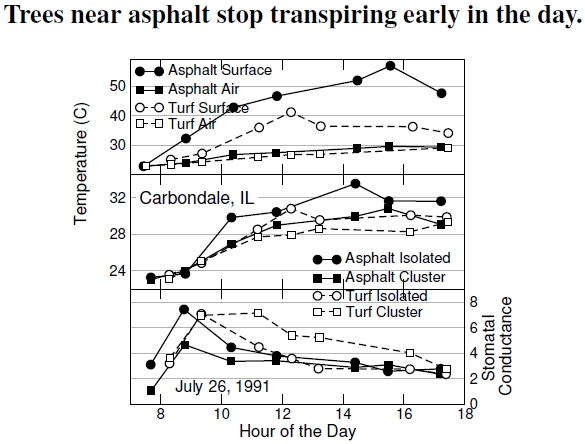2.15 Hot Trees
Figure 2.15: Temperature and stomatal conductance of trees surrounded by turf or asphalt on July 26, 1991, in Carbondale, Illinois (after Kjelgren and Montague 1998). The top graph shows the surface (circles) and air temperatures (squares) measured over a 60 m x 110 m paved parking lot (filled symbols) and a nonirrigated turf lawn (open symbols). “Stomatal conductance” measures, in essence, the water flowing out of a leaf’s stoma.
Trees are living organisms with traits shaped through natural selection. Evapotranspiration rates shown in Figure 2.14 came from happy forest trees living in the right environment. Unless very carefully chosen and maintained, planting a tree in a parking lot places it far from these ideal, evolutionarily appropriate, environmental conditions. How does a tree deal with urban environments?
The top graph in Figure 2.15 shows surface and air temperatures at a paved parking lot and an unirrigated open-turf lawn with normal sunlight levels.[47] At the surface, parking lot temperatures (measured by an infrared thermometer) exceed the turf’s by as much as 25C, yet for air temperatures at 2 m height (6 ft), air movement equalizes both temperatures to broader atmospheric conditions. Also note the delayed decrease in the asphalt surface temperature relative to the turf surface temperature — another demonstration of the thermal mass effect.
Now put trees into the picture. Researchers placed potted flowering pear trees, Pyrus callyerana, on the two surfaces either isolated from other trees or clustered within a group of eight other trees. The middle plot shows that trees grouped over turf, perhaps not surprisingly, experienced the lowest leaf temperatures, whereas an isolated tree over asphalt saw the highest leaf temperatures. Indeed, parking lot trees’ leaves were hotter by about 2–4C.
The bottom graph displays a physiological measurement called stomatal conductance–essentially a measure of water flowing out of a leaf’s stoma, or the final step in transpiration. Stomatal conductance declined after midmorning for parking lot trees, either in isolation or in a group, but remained higher for trees grouped over turf. Follow-up studies examined actual water loss by trees and more or less confirmed the stomatal conductance results: In some cases there was no significant difference between the asphalt and turf situations, and in others, trees on asphalt transpired less water because they closed their stomata due to the heat.
Parking lot trees have it rough. The long-wavelength radiation coming from the hot asphalt heats the trees up from below and shuts their photosynthetic processes down. Cooling requires mass plantings, perhaps taking away more parking spaces, or perhaps grassy paving (Figure 2.18).
All in all, shade trees can be really shady. One study, performed in Thessaloniki, Greece, indicated that a paper mulberry, Brussonetia papirifera, found in an urban park, won the cooling competition: A single tree reduced temperatures by 5–20 degrees Celsius, or 9–35 degrees Fahrenheit![48]
——————
[47]Kjelgren and Montague (1998) measured tree temperatures, stomatal conductance, and water loss over paved and turf surfaces, and also considered ash and maple trees.
[48]Georgi and Zafiriadis (2006) performed the study of shade trees in Thessaloniki, Greece.
